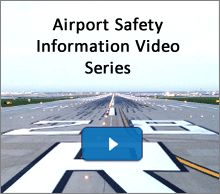Definitions – Part 139 Airport Certification
Terms Used in 14 CFR Part 139
The revised Part 139 contains more definition than those shown below.
- Air Carrier - a person who undertakes directly by lease, or other arrangement, to engage in air transportation. This includes an individual, firm, partnership, corporation, company, association, joint-stock association, governmental entity, and a trustee, receiver, assignee, or similar representative of such entities. [See 14 CFR Part 1.1, General definitions.]
- Air Carrier Aircraft - an aircraft that is being operated by an air carrier and is categorized, as determined by the aircraft type certificate issued by a competent civil aviation authority, as either a
- large air carrier aircraft - if designed for at least 31 passenger seats or
- small air carrier aircraft - if designed for more than 9 passenger seats but less than 31 passenger seats.
- Class I Airport - an airport certificated to serve scheduled operations of large air carrier aircraft that can also serve unscheduled passenger operations of large air carrier aircraft and/or scheduled operations of small air carrier aircraft.
- Class II Airport - an airport certificated to serve scheduled operations of small air carrier aircraft and the unscheduled passenger operations of large air carrier aircraft. A Class II airport cannot serve scheduled large air carrier aircraft.
- Class III Airport - an airport certificated to serve scheduled operations of small air carrier aircraft. A Class III airport cannot serve scheduled or unscheduled large air carrier aircraft.
- Class IV Airport - an airport certificated to serve unscheduled passenger operations of large air carrier aircraft. A Class IV airport cannot serve scheduled large or small air carrier aircraft.
- Joint-Use Airport - means an airport owned by the Department of Defense, at which both military and civilian aircraft make shared use of the airfield. [Revised by Final Rule: Safety Enhancements, Certification of Airports (78 FR 3311), 1/16/2013 ]
- Movement Area - the runways, taxiways, and other areas of an airport that are used for taxiing, takeoff, and landing of aircraft, exclusive of loading ramps and aircraft parking areas.
- Safety Area - a defined area comprised of either a runway or taxiway and the surrounding surfaces that is prepared or suitable for reducing the risk of damage to aircraft in the event of an undershoot, overshoot, or excursion from a runway or the unintentional departure from a taxiway.
- Scheduled Operation - any common carriage passenger-carrying operation for compensation or hire conducted by an air carrier for which the air carrier or its representatives offers in advance the departure location, departure time, and arrival location. It does not include any operation that is conducted as a supplemental operation under 14 CFR Part 121 or public charter operations under 14 CFR Part 380.
- Unscheduled Operation - any common carriage passenger-carrying operation for compensation or hire, using aircraft designed for at least 31 passenger seats, conducted by an air carrier for which the departure time, departure location, and arrival location are specifically negotiated with the customer or the customer's representative. This includes any passenger-carrying supplemental operation conducted under 14 CFR Part 121 and any passenger-carrying public charter operation conducted under 14 CFR Part 380.
Contact Us
Popular Information
Popular Downloads
- Part 139 Airport Certification Status List
- Airports with 5G Buffers
- CertAlert 21-01, Aqueous Film Forming Foam (AFFF) Testing at Certificated Part 139 Airports (PDF)
- CertAlert 21-04, Updated Guidance for Airport Emergency Plans (AEP) under 14 CFR Part 139.325(b)(7) (PDF)
- CertAlert 21-05, Part 139 Extinguishing Agent Requirements
Diesel Exhaust Fluid and Fuel System Icing Inhibitor Video
Control of Fuel System Icing Inhibitor and Diesel Exhaust Fluid at Airports
FAA Disclaimer: The Energy Institute (EI) produced the video. The EI is a non-profit chartered professional membership body, based in the United Kingdom, that brings together professionals working globally across the energy sector. The body works to address global challenges and uses their skills and knowledge to suggest safety practices that also protect the environment. The FAA encourages users of the aviation system to clearly and safely label Diesel Exhaust Fluid and Fuel System Icing Inhibitor and keep them stored in separate areas, to avoid any accidental mixing of fluids.Last updated: Tuesday, May 2, 2023



